Authenticity Identification of Panax notoginseng by Terahertz Spectroscopy Combined with LS-SVM
Due to the time consuming and great complexity of traditional identification methods, the authenticity of Panax notoginseng is identified by terahertz time domain spectroscopy (THz-TDS) combined with a least square support vector machine (LS-SVM) in our study. The original time domain and frequency domain spectral information of Panax notoginseng are firstly collected in a frequency range of 0.2–2.0 THz. The spectral data are pretreated with the standard normal variate (SNV) algorithm. Then, the competitive adaptive reweighted sampling (CARS) algorithm is used to screen the frequency domain spectral data to obtain the final characteristic spectral data. Finally, the identification models of support vector machine (SVM), LS-SVM and backpropagation neural network (BPNN) are established with the screened spectral data. By comparison, it is found that the LS-SVM model has a better identification result with an accuracy of 90.4% and an error rate of 9.6%, respectively. This suggests that the LS-SVM model has a higher identification accuracy. Research results show that THz-TDS can effectively obtain the information of Panax notoginseng. The THz-TDS combined with LS-SVM can be used to effectively identify the authenticity of Panax notoginseng, which has a practical significance and broad application potential.
Panax notoginsengis a traditional precious Chinese medicine with great medicinal values such as hemostasis, enriching blood, acesodyne, angiectasis and detumescence. Hence, more and more people take Panax notoginseng for health care and treatment. Due to the larger demand and higher price of Panax notoginseng in the medicine supplement market, some unscrupulous traders sell the substandard products for profiteering, resulting in some fake Panax notoginseng in the market. For example, some unscrupulous traders pass Gynura segetum, Anredera cordifolia, and Panax stipuleanatus off as the genuine Panax notoginseng. Moreover, the Rhizoma Curcumae and dried bamboo root after carving are passed off as the genuine Panax notoginseng for sale. After eating the fake Panax notoginseng, there would appear some symptoms, such as headache, dizziness, palpitation, chest discomfort, shortness of breath, abdominal pain, abdominal distension, and diarrhea. Therefore, it is particularly necessary to accurately identify the authenticity of Panax notoginseng to ensure safety and effectiveness, which is of great significance to ensure the health of consumers.
Researchers have adopted many methods to accurately identify and distinguish the authenticity of Panax notoginseng, including personal experience (1), mass spectrometry detection (2), physical methods (3), and chemical methods (4–5). However, it is increasingly difficult to identify counterfeit medicine by personal experience. Furthermore, traditional mass spectrometry detection and chemical extraction methods are complex and time-consuming, with long-term sample preparation as well as high requirements for professional competence and equipment, which makes researchers unable to satisfy the practical requirement for on-site, fast and simple identification. Hence, it is urgent to explore new effective detection method and identification technology.
The terahertz spectrum, an electromagnetic wave in a frequency range of 0.1–10 THz with very low energy, can identify the chemical components in mixtures without sample damage, thus becoming a promising nondestructive testing method. In recent years, some researchers have used terahertz spectroscopy to identify and analyze Chinese medicine supplements, achieving positive results. Bin and associates (6) used terahertz spectra to identify different parts of Panax notoginseng (taproot, scissor root, rib, and hairy root), with up to 100% accuracy. The terahertz spectroscopy and chemometrics method were used by Wang and colleagues (7) to identify the authenticity of rheum officinale. Likewise, Liang and associates (8) used the terahertz spectroscopy and pattern recognition method to identify the origin of Scutellaria baicalensis, reaching a sample recognition rate of 95.56%, which suggests that the origin of Scutellaria baicalensis can be effectively identified by using terahertz spectroscopy and a pattern recognition method together. The American ginseng was identified by terahertz time domain spectroscopy combined with chemometric methods by Lingyu and colleagues (9), with a recognition rate up to 98%, implying that the identification results are reliable and practical. Yang and associates (10) used terahertz spectra to identify safflower and bezoar, obtaining the classification accuracies of 100% and 90%, respectively. Their results provide the theoretical basis for the identification of safflower and bezoar saffron.
As can be seen from the above research results, terahertz time domain spectroscopy has become a premier detection technology to identify Chinese herbal medicines. However, until now, there are few research papers on the authenticity identification of Panax notoginseng by terahertz spectroscopy. Therefore, further research is still needed. Here, the authenticity of Panax notoginseng is identified by terahertz spectroscopy combined with LS-SVM, and the optimal identification model for Panax notoginseng is constructed. Firstly, the information of time domain spectra and frequencydomain spectra of genuine Panax notoginseng and fake Panax notoginseng are obtained in the frequency range of 0.2–2.0 THz. The features are extracted from the original terahertz spectrum signals to decrease the dimensionality of original data. Then, identification models of genuine Panax notoginseng and fake Panax notoginseng are established. Finally, the performance of identification models are evaluated for accuracy and sensitivity.
Experiment
Samples and Pretreatment
Five species of typical Panax notoginseng were collected from Wenshan in Yunnan Province of China with the largest production occurring from 2021 to 2022—namely, Panax notoginseng (Notoginseng radix), Gynura root (Gynurasegefum), Madeira vine (Anredera cordifolia), Zedoary (Rhizoma curcumae), and Lobedfruit Schizocapsa Rhizome (Schizocapsaplantaginea Hance). Among these, the Panax notoginsengis the genuine product, and the remainders are fake, as shown in Figure 1. The main chemical components of Panax notoginseng are saponins, such as ginsenosides Rg1 and Rb1. The main chemical components of Gynura root are pyrrolizidine alkaloids, such as Ju Sanqi alkaloid. The main chemical components of Madeira vine are diosgenin, carotenoids, various amino acids, and minerals. The main chemical components of Zedoary rhizome are volatile oils, such as curcumol and zedoary lactone. The main chemical components of Lobedfruit schizocapsa rhizome are flavonoids, including coumarins, sterols, and volatile oils. For each Chinese medicine, 48 samples are prepared, and thus, a total of 240 samples are obtained. The samples are ground using a grinder and agate mortar, then dried and weighed to pass a 200-mesh sieve. The powder is put into the mold, and pressed to the circular tablet with a thickness of 1.2 mm and a diameter of 13 mm. Finally, a polyethylene tablet is prepared separately having the same size.
FIGURE 1: Experimental samples.
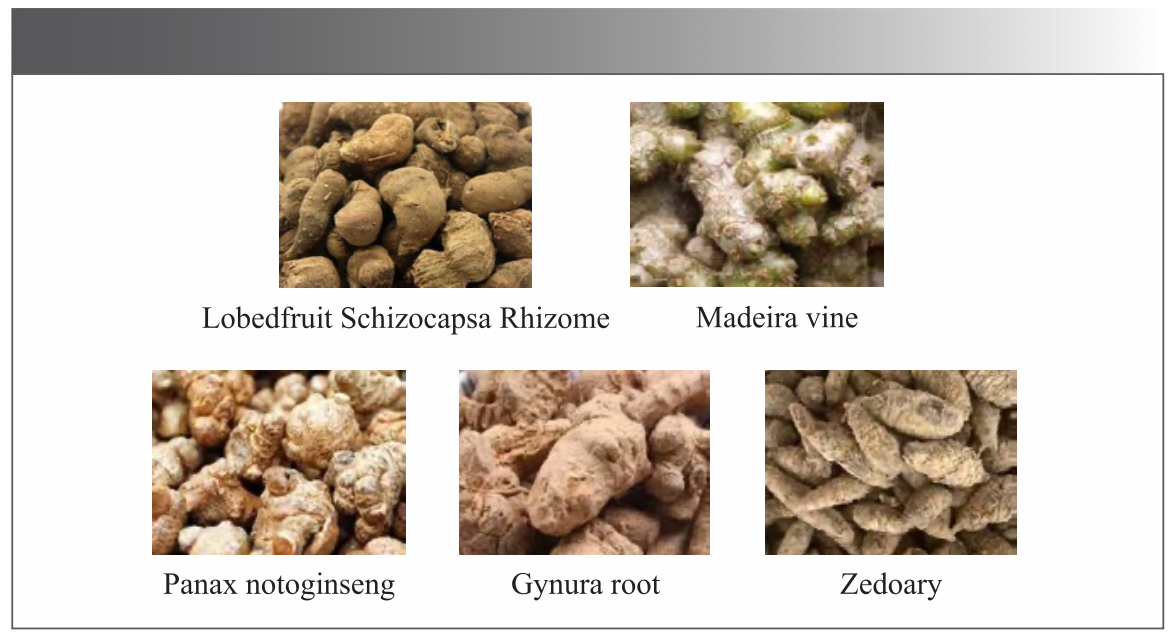
Spectrum Collection and Sample Division
A terahertz time domain spectroscopy instrument (THz-TDS) manufactured by Menlo Systems GmbH in Germany was used in the experiment, with a center wavelength of 1550 nm and an optical power of 33 mW for the terahertz generator and detector. After preheating for half an hour, the THz-TDS reaches a stable state, and the samples are then characterized by transmission spectra. Three spectra are collected for each sample (with a total of 720 spectra data obtained from 240 samples).Subsequently, the Kolmogorov–Smirnov (KS) algorithm is adopted to divide the calibration set and prepare a prediction set for 720 spectra data. As a result, there are 504 spectra samples in the calibration set, and the remaining 216 are in the prediction set.
During the test process, there is a certain degree of sample dryness maintained for the Panax notoginseng powder so as to avoid the absorption of terahertz pulses by water molecules in both the powder and the air. Simultaneously, the sealed experimental device is filled by dry nitrogen to keep the temperature at 20 ° C and the relative humidity at less than 5%.
Data Processing and Methods
Spectrum Pretreatment
In terahertz spectra, offset, drift, noise, and other interference signals appear, which could affect the accuracy of modeling analysis. In order to eliminate the influence of interference signals on model stability, the standard normal variate (SNV) method is employed to pretreat the spectra in order to enhance the identification information of samples.
The SNV can effectively remove the influence of solid particle size on the spectra, mainly through processing the data of each row in the spectral matrix (11). The calculation process is according to equation 1:

Where x is the initial value of SNV of the sample, and x– is the average value of SNV of the sample. For i = 1,2,⋯, w, w is the number of corresponding frequencies. The mathematical models proposed by Dorney (12) and Duvillaret (13) are adopted to obtain the frequency domain spectra signals after the Fourier transform for time domain spectra signals.
Modeling and Evaluation
Some studies (14–19) have reported that the material is analyzed with terahertz and stoichiometric methods (such as principal component analysis, partial least squares, and support vector machine) together; while achieving good results. In our study, the SVM, LS-SVM, and BPNN methods are used for modeling of five species of Panax notoginseng and to identify their authenticity. The identification performance of different models is compared based on the results from different calibration and prediction sets. The precision, recall (sensitivity), and accuracy are selected as the evaluation criteria of the models. Accordingly, the higher the accuracy is, the smaller the difference between the measured value and the true value. Thus, the prediction ability of the model is stronger, and the model is more stable.
The precision (P) is calculated as follows:

The recall (sensitivity) is:

The accuracy is:

In equation 2, equation 3, and equation 4, true positive (TP) and true negative (TN) suggest that the prediction results are correct, but false positive (FP) and false negative (FN) suggest that the prediction results are wrong.
Results and Discussion
Time Domain Spectrum and Frequency Domain Spectrum Analyses
In order to decrease errors, the time domain spectra of each sample are measured, and the average value is taken. The average time domain spectra of different kinds of Panax notoginseng are presented in Figure 2. It can be seen that there exists an obvious time lag between the time domain spectrum of each sample and that of the reference signal (air). Their waveforms and pulse amplitudes are also different. The peak value of each sample attenuates in a different degree with the time. By comparing the terahertz spectra of the five substances, differences in location and intensity in the time domains can be observed, reflecting differences in their molecular structures, which may be related to the types of chemical bonds within the molecules, vibration patterns, and intermolecular interactions. Notably, the attenuation of time domain amplitude of Panax notoginseng is the smallest, however, that of Madeira vine is the largest. The longer the scanning time, the longer the time delay of the sample signal, and thus the more serious is the peak attenuation.
FIGURE 2: (a) Time domain spectra of different Panax notoginseng varieties; (b) Frequency domain spectra of different Panax notoginseng varieties.
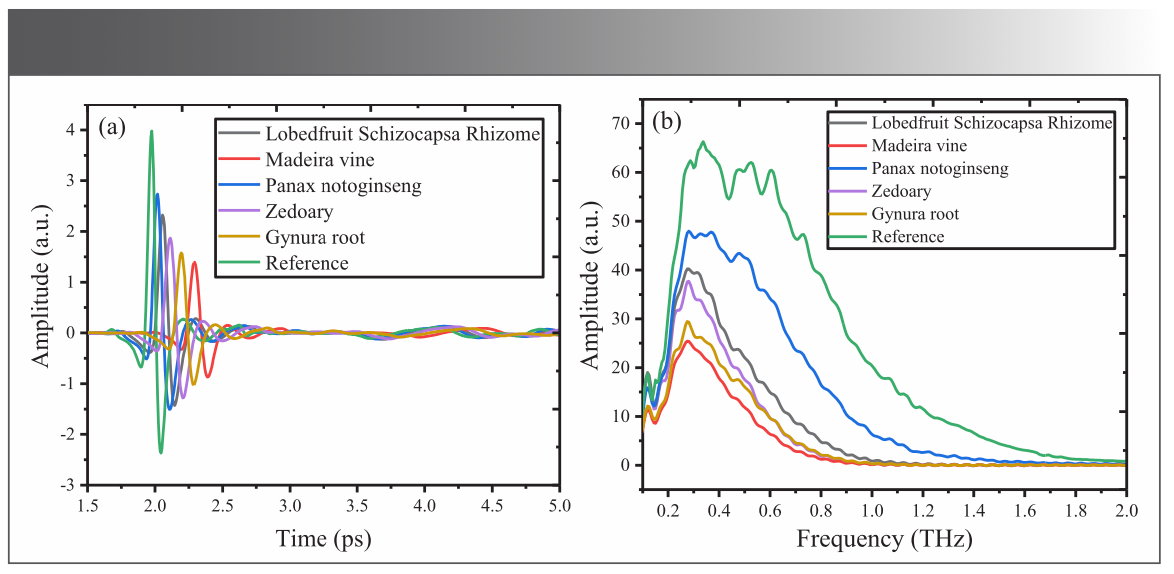
By comparing the terahertz spectra of the five substances, differences in location and intensity in the time domains can be observed, reflecting differences in their molecular structures, which may be related to the types of chemical bonds within the molecules, vibration patterns, and intermolecular interactions.
The fast Fourier transform (FFT) method is used to convert the time domain spectrum to the frequency domain spectrum, as displayed in Figure 2. The amplitudes of different kinds of Panax notoginseng are significantly different from that of reference signal. Moreover, the amplitude of frequency domain spectrum significantly changes at 0.29 THz. Thus, there exists obvious difference in the amplitudes between genuine and fake Panax notoginseng due to the absorption of terahertz wave by genuine Panax notoginseng being different from that by the fake, which is caused by the differences in the chemical compositions of the samples. Therefore, it is concluded that the authenticity of Panax notoginseng can be identified by the frequency domain spectra values. In terahertz time-domain and frequency-domain spectroscopic analysis, the variation in chemical composition among different species results in changes in time-domain curves and spectral feature peaks, providing us with an effective tool to authenticate and distinguish between different species.
Extraction of Characteristic Frequency
There are generally much more useless interference data in the spectra data. If they are all input to the model, the computation speed of model would decrease. Therefore, in order to improve the computation speed, the characteristic frequencies are extracted from the original spectra data to replace the original data, which reduces the computation amount and shortens the modeling time.
The competitive adaptive reweighted sampling (CARS) algorithm is used to screen the characteristic variables to obtain the variable set for authenticity identification of Panax notoginseng. The selection process is shown in Figure 3, in which the number of sampled variables (NSV), root mean square error of cross validation (RMSECV), and regression coefficient path in the CARS algorithm change with the sampling times.
FIGURE 3: Screening results of CARS characteristic variables.
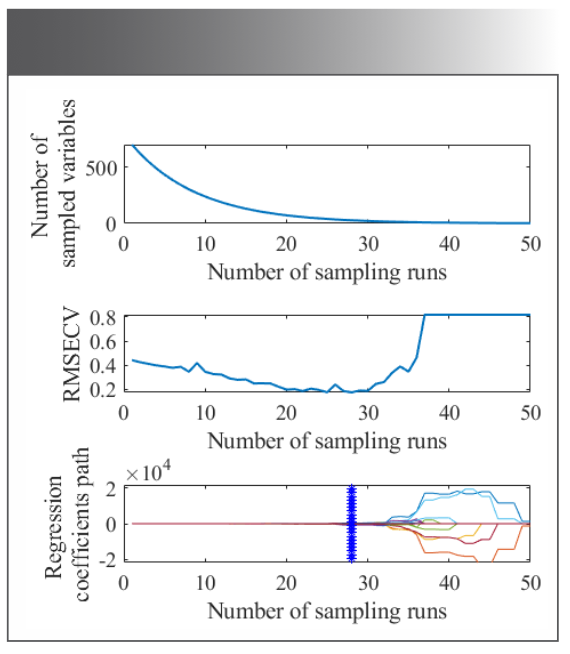
The Monte Carlo sampling is set to 50, and the number of cross validation iterations are set to 5. When the sampling reaches the 28th iteration, the RMSECV achieves its minimum value of 0.175. However, when the sampling exceeds 37 iterations, the RMSECV sharply increases to 0.818, and the model’s accuracy declines. This suggests that important and useful information in the spectral data has been eliminated. Therefore, the 28th sampling iteration, where the RMSECV is minimized, can be considered the optimal result. Based on the optimal sampling times of CARS algorithm, a total of 22 subsets of characteristic variables are selected as the final variable combination.
Construction and Analysis of Model
SVM Modeling Analysis Based on Different Varieties of Panax Notoginseng
A commonly used qualitative classification algorithm, SVM shows good classification performance, especially for smaller sample sets. The SVM algorithm can be used to construct the model with the characteristic wavelength variables selected by the CARS algorithm so as to identify the authenticity of Panax notoginseng. Furthermore, the kernel function of the SVM algorithm adopts the radial basis function, as well as the penalty factor and kernel parameters are optimized by tenfold cross validation. The confusion matrix of the SVM model is demonstrated in Figure 4. By comparing the target class (horizontal coordinates) with the output class (vertical coordinates), the confusion matrix can describe the individual classification performance of each model.
FIGURE 4: Confusion matrix of SVM model.
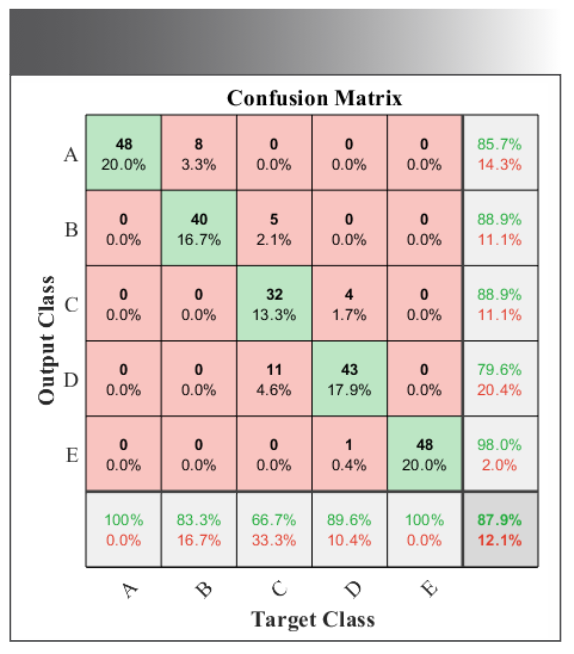
There, the Panax notoginseng, Gynura root, Madeira vine, Zedoary, and Lobedfruit Schizocapsa Rhizome are represented by A, B, C, D, and E, respectively.
In terms of the five varieties, A is accurately identified. Eight samples of B are identified as A. Five samples of C are identified as B, and eleven samples are identified as D. Four samples of D are identified as C, and one sample is identified as E. E is accurately identified. Thus, the precisions of A, B, C, D, and E are 85.7%, 88.9%, 88.9%, 79.6%, and 98.0%, respectively.
Simultaneously, the recalls of A, B, C, D, and E are 100%, 83.3%, 66.7%, 89.6%, and 100%, respectively. As such, the comprehensive identification accuracy of five medicines is 87.9%.
BPNN Modeling Based on Different Varieties of Panax Notoginseng
After pretreatment and screening of characteristic frequency, the BPNN model is established for terahertz frequency domain spectra, and fivefold cross validation is adopted. Figure 5 shows the confusion matrices of five different kinds of samples from the BPNN model.
FIGURE 5: Confusion matrix of BPNN model.
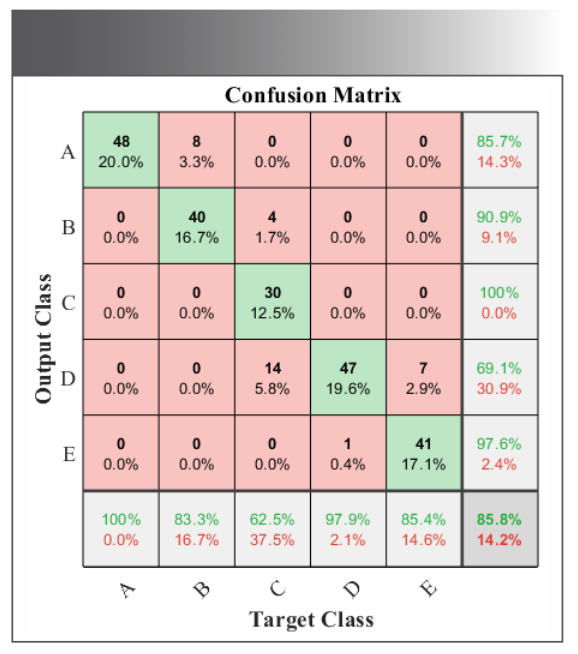
Clearly, A is accurately identified. Eight samples of B are identified as A. Four samples of C are identified as B, and 14 samples are identified as D. One sample of D is identified as E. Seven samples are identified as D. Moreover, the precision values of A, B, C, D, and E are 85.7%, 90.9%, 100%, 69.1%, and 97.6%, respectively.
The recalls of A, B, C, D, and E are 100%, 83.3%, 62.5%, 97.9% and 85.4%, respectively. Among them, the recall of C is the lowest. Accordingly, the comprehensive identification accuracy of the five medicines is 85.8%.
LS-SVM Modeling Based on Different Varieties of Panax Notoginseng
The LS-SVM is likewise employed to construct a classification model for the absorption spectral data, and a fivefold cross validation is adopted. The confusion matrix is presented in Figure 6.
FIGURE 6: Confusion matrix of LS-SVM model.

For the five medicines, A is accurately identified. Eight samples of B are identified as A. Four samples of C are identified as B, and seven samples are identified as D. One sample of D is identified as E. Three samples are identified as D.
Furthermore, the precisions of A, B, C, D, and E are 85.7%, 90.9%, 100%, 82.5%, and 97.8%, respectively.
The recalls of A, B, C, D, and E are 100%, 83.3%, 77.1%, 97.9% and 93.8%, respectively. Therefore, the comprehensive identification accuracy of five medicines is 90.4%.
Comparative Analysis of Models
The SNV and CARS are used for pretreatment and feature selection of terahertz data, respectively. Subsequently, the SVM, BPNN, and LS-SVM models are established. The optimal prediction model for the authenticity identification of Panax notoginseng is determined by comparing the prediction performances of different models. Table I lists the prediction results of different models, and reveals that LS-SVM model has a better prediction effect with a better performance for each evaluation index, superior to the SVM and BPNN models.

Conclusions
In this paper, the authenticity of different varieties of Panax notoginseng is identified using THz-TDS combined with LS-SVM. The main conclusions are as follows.
1) Based on THz-TDS information of five varieties of Panax notoginseng, there exist obvious amplitude difference, time delay in time domain spectra, and frequency domain spectra of different varieties in a frequency range of 0.2–2 THz, demonstrating that the terahertz spectra can be adopted to identify different Chinese medicines, ascribed to the difference in molecular groups.
2) In order to improve the accuracy of authenticity identification, the SVM, LS-SVM, and BPNN identification models are established after the pretreatment by SNV and characteristic frequency screening by CARS for frequency domain spectra data, respectively. By comparison, it is found that the accuracy of the SVM model is 87.9%, and the error rate is 12.1%. The accuracy of BPNN model is 85.8%, and the error rate is 14.2%. The accuracy of LS-SVM model is 90.4%, and the error rate is 9.6%. As such, the precision, recall and accuracy of the LS-SVM models are all higher than those of SVM and BPNN models, showing that the LS-SVM model has a better ability to analyze the frequency domain spectra data. Thus, it is feasible to identify the authenticity of Panax notoginseng by THz-TDS combined with LS-SVM, with a broad application potential.
Conflicts of Interest
There are no conflicts to declare.
Funding Statement
This work was supported by the Intelligent Medicine Research Project of Chongqing Medical University (Grant No. ZHYXQNRC202207), the Program for Youth Innovation in Future Medicine, Chongqing Medical University (Grant No. W0138), Youth Project of Science and Technology Research Program of Chongqing Education Commission of China (Grant No. KJQN202103112), Key Project of Science and Technology Research Program of Chongqing Education Commission of China (Grant No. KJZD-K202203104), the Science and Technology Research Program of Chongqing Municipal Education Commission (Grant No. KJQN202400412) and the Science Technology Research Program of Chongqing Municipal Education Commission (Grant No. KJQN202200908) and the Science and Technology Project of Luzhou Municipal Science and Technology Bureau (Grant No. 2024JYJ025) and Key Research and Development Plan of Luzhou City Science and Technology Bureau (Grant No. 2024NYF120).
Author Contributions
Writing, original draft, Yin Shen; Conceptualization, Song Bai and Shengkun Wei; Investigation, Yanan Zhao; Methodology, Shuyan Peng; Project administration, Liping Wan; Resources, Ming Ai and Wende He; Software, Xiuhua Li and Yuan Diao; Writing, review & editing, Renqiang Yang.
Data Availability Statement
Due to the nature of this research, participants of this study did not agree for their data to be shared publicly, as the data also forms part of an ongoing study.
References
- Chen, M.; Chen, Z.; Cui, X.; Zhang, Y.; & Wang, S. Research on Taproots Identification Technology in Panax notoginseng Quality Intelligent Management System. Comput. Intel. Neurosc. 2021, 8292535. DOI:10.1155/2021/8292535
- Kim, S.; Shin, B. K.; Lim, D. K.; Yang, T. J.; Lim, J.; Park, J. H.; Kwon, S. W. Expeditious Discrimination of Four Species of the Panax Genus Using Direct Infusion-MS/MS Combined with Multivariate Statistical Analysis. J. Chromatogr. B 2015, 1002, 329–336. DOI: 10.1016/j.jchromb.2015.08.034
- Ichim, M.C.; Boer, H. D. C.A Review of Authenticity and Authentication of Commercial Ginseng Herbal Medicines and Food Supplements. Front. Pharmacol. 2021, 11, 612071. DOI:10.3389/fphar.2020.612071
- Liu, F.; Wang, Y. Z.; Yang, C. Y.; Jin, H. Study on the Genuineness and Producing Area of Panax notoginseng Based on Infrared Spectroscopy Combined with Discriminant Analysis. Spectrosc. Spect Anal. 2015, 35 (1), 108–112. DOI:10.3964/j.issn.1000-0593(2015)01-0108-05
- Feng, W.; Lixing, N.; Jiandong, Y.; Zhong, D.; Shuangcheng, M. Study on Specific Identification Method of Notoginseng Radix et Rhizoma in Huoxue Zhitong Preparations. Chin. Pharm. Aff. 2019. DOI: 10.16153/j.1002-7777.2019.07.007
- Bin, L.; Zhaoyang, H.; Huizhou, C.; A-Kun, Y.; Ai-Guo, O. Y. Identification of Different Parts of Panax notoginseng Based on Terahertz Spectroscopy. J. Anal. Sci. Technol. 2022, 13 (1), 1–10. DOI: 10.1186/s40543-022-00328-3
- Wang, J. R.; Zhang, Z. Y.; Zhang, Z. W.; Xiang, Y. H. Identification of Official Rhubarb Samples by Using PLS and Terahertz Time-Domain Spectroscopy. Guang Pu Xue Yu Guang Pu Fen Xi 2016, 36 (02), 316–321. DOI: 10.3964/j.issn.1000-0593(2016)02-0316-06
- Liang, J.; Qijia, G.; Tianying, C. Reliable Origin Identification of Scutellaria baicalensis Based on Terahertz Time-Domain Spectroscopy and Pattern Recognition. Optik 2018, 174, 7–14. DOI: 10.1016/j.ijleo.2018.08.050
- Lingyu, L.; Chang, T.; Zhang, X.; Cui, H. L. Identification of American Ginseng by Terahertz Time Domain Sspectroscopy Combined with Principal Component Analysis and Linear Discriminant Analysis. Shenzhen Daxue Xuebao 2019, 36 (2), 207. DOI: 10.3724/SP.J.1249.2019.02207
- Yang, Y. P.; Zhang, C.; Liu, H. S.; Zhang, Z. W. Identification of Two Types of Safflower and Bezoar by Terahertz Spectroscopy. Guang Pu Xue Yu Guang Pu Fen Xi 2019, 39 (01), 45-49. DOI: 10.3964/j.issn.1000-0593(2019)01-0045-05
- Barnes, R. J.; Dhanoa, M. S.; Lister, S. J. Standard Normal Variate Transformation and De-Trending of Near-Infrared Diffuse Reflectance Spectra. Appl. Spectrosc. 2016, 43 (5), 772–777. DOI: 10.1366/0003702894202201
- Dorney, T. D.; Baraniuk, R. G.; Mittleman, D. M. Material Parameter Estimation with Terahertz Time-Domain Spectroscopy. J. Opt. Soc. Am. A 2001, 18 (7), 1562. DOI: 10.1364/JOSAA.18.001562
- Duvillaret, L.; Garet, F.; Jean-Louis, C. Highly Precise Determination of Optical Constants and Sample Thickness in Tterahertz Time-Domain Spectroscopy. Appl. Opt. 2008, 38 (2), 409. DOI: 10.1364/AO.38.000409
- Suhandy, D.; Ogawa, Y.; Kondo, N.; Yulia, M. Feasibility of Using Attenuated Total Reflectance Terahertz (ATR-THz) Spectroscopy for Quantitative and Qualitative Study of Vitamin C in Aqueous Solutions. ASABE 2011. DOI: 10.13031/2013.38176
- Hua, Y.; Zhang, H., Qualitative and Quantitative Detection of Pesticides With Terahertz Time-Domain Spectroscopy. IEEE Trans. Microw. Theory Tech. 2010, 58 (7), 2064–2070. DOI: 10.1109/TMTT.2010.2050184
- Guohui, H.; Changsheng, G.; Jianjun, L.; Hong, Z. Qualitative and Quantitative Detections of Pyrethroid Pesticides by Terahertz Time-Domain Spectroscopy. Guang Pu Xue Yu Guang Pu Fen Xi 2012, 32 (05), 1184–1188. DOI: 10.3964/j.issn.1000-0593(2012)05-1184-05
- Qin, J.; Xie, L.; Ying, Y. Feasibility of Terahertz Time-Domain Spectroscopy to Detect Tetracyclines Hydrochloride in Infant Milk Powder. Anal. Chem. 2014, 86 (23), 11750-11757. DOI: 10.1021/ac503212q
- Smith, G.; Hussain, A.; Bukhari, N. I.; Ermolina, I. Quantification of Residual Crystallinity in Ball Milled Commercially Sourced Lactose Monohydrate by Thermo-Analytical Techniques and Terahertz Spectroscopy. Eur. J. Pharm. Biopharm. 2015, 92, 180–191. DOI: 10.1016/j.ejpb.2015.02.026
- Sleiman, J. B.; Bousquet, B.; Palka, N.; Mounaix, P. Quantitative Analysis of Hexahydro-1,3,5-trinitro-1,3,5, Triazine/Pentaerythritol Tetranitrate (RDX–PETN) Mixtures by Terahertz Time Domain Spectroscopy. Appl. Spectrosc. 2015, 69 (12), 1464–1471. DOI: 10.1366/15-07937
Yin Shen, Shuyan Peng, Liping Wan, and Fanghong Bi are with the College of Medical Information at Chongqing Medical University, Chongqing, China. Yanan Zhao is with the Department of Pharmacy at Chongqing University Cancer Hospital, in Chongqing, China. Song Bai and Guoyong Zhang are with Sichuan Vocational College of Chemical Industry, in Luzhou, China. Shengkun Wei is with Luzhou Vocational and Technical College, in Luzhou, China. Yuan Diao is with the Department of Ophthalmology at Affiliated Hospital of Southwest Medical University, in Luzhou, China. Ming Ai is with the Department of Psychiatry at The First Affiliated Hospital of Chongqing Medical University, in Chongqing, China. Renqiang Yang is with the Chongqing College of Electronic Engineering, in Chongqing, China. Xiuhua Li is with the College of Language Intelligence at Sichuan International Studies University, in Chongqing, China. Direct correspondence to: Yanan Zhao (zyn15823490395@163.com) and Shengkui Wei (1010874602@qq.com). Yin Shen and Xiuhua Li contributed equally to this work.
Geographical Traceability of Millet by Mid-Infrared Spectroscopy and Feature Extraction
February 13th 2025The study developed an effective mid-infrared spectroscopic identification model, combining principal component analysis (PCA) and support vector machine (SVM), to accurately determine the geographical origin of five types of millet with a recognition accuracy of up to 99.2% for the training set and 98.3% for the prediction set.
Evaluation and Development Trends of Optical Detection Technology for Seed Vigor
In this article, the basic principles, advantages, and limitations of different optical techniques for obtaining seed vigor estimates are introduced and reviewed, and the key technology of non-destructive optical detection of single seeds will be discussed.